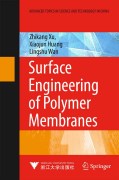Surface Engineering of Polymer Membranes covers the processes that modify membrane surfaces to improve their in-service performance, meaning, to confer surface properties which are different from the bulk properties. Purposes may be to minimize fouling, modulate hydrophilicity/ hydrophobicity, enhance biocompatibility, create diffusion barriers, provide functionalities, mimic biomembranes, fabricate nanostructures, etc. First, the basics of surface engineering ofpolymer membranes are covered. Then topics such as surface modification by graft polymerization and macromolecule immobilization, biomimetic surfaces, enzyme immobilization, molecular recognition, and nanostructured surfaces are discussed. This book provides a unique synthesis of the knowledge of the role of surface chemistry and physics in membrane science. Presents comprehensive studies on the chemical and physical behaviors of membrane surfaces Provides a unique synthesis of our knowledge on the role of surface engineering in membrane science Elaborates novel methods for constructing bio-functional membranes fromtraditional polymer membranes Will serve as an informative reference source of value to expert and non-expert alike INDICE: Introduction.- Functionalization methods for the membrane surfaces.- Characterization of structure and properties for the membrane surfaces.- Surface modification by Graft polymerization.- Surface modification by macromolecule immobilization.- Membranes with phospholipid analogous surfaces.- Membranes with glycosylated surfaces.- Membranes with biocatalytic surfaces.- Molecular imprinting on the membrane surface.- Nanofibrous membrane with functionalized surface.
- ISBN: 978-3-540-88412-5
- Editorial: Springer
- Encuadernacion: Cartoné
- Páginas: 348
- Fecha Publicación: 01/01/2009
- Nº Volúmenes: 1
- Idioma: Inglés

